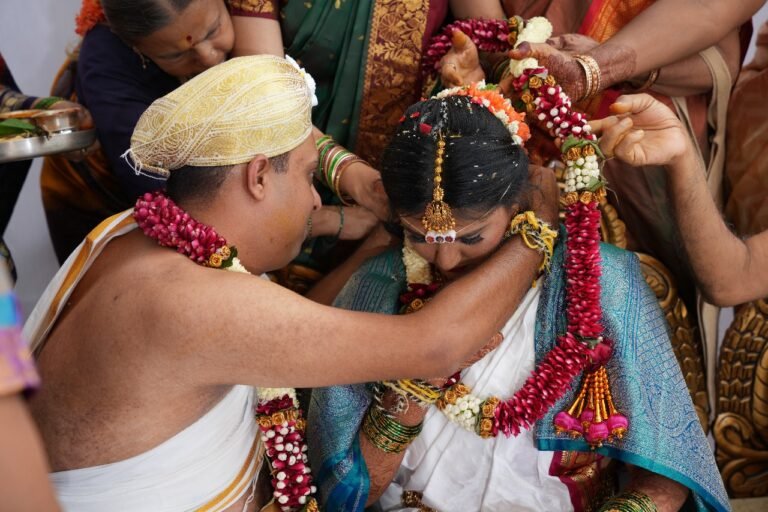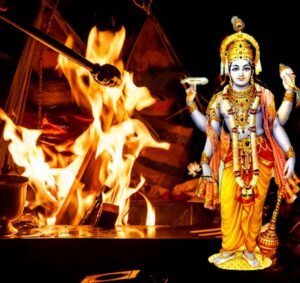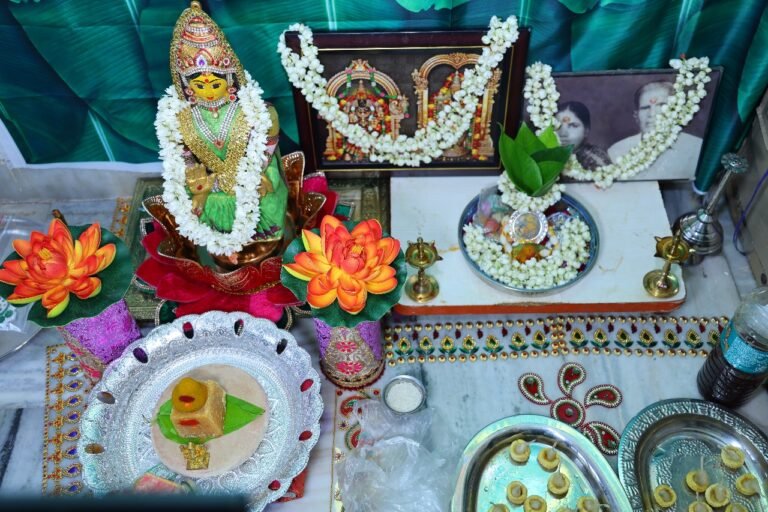Marriage

SAMAVARTANE
The bridegroom performs the samavartane fire ritual (homa)to mark his entry into grihasthashrama from brahmacharya. He seeks the blessings of Prajapathi, Pavana, Agni and Surya. Henceforth he is called a snathaka and will perform his duties to devas, pitrus and society along with his wife.
GAURI POOJE
While the Bridegroom performs the Samavartana Homa and is taken for Kashi Yatre, the Bride performs “Gowri Puje” under the guidance of elderly women according to tradition. Parvati, Shiva’s consort, obtained Shiva after long and arduous Tapas. The bride prays to the Divine Mother in her avatar as Gauri so that she may remain ever devoted to her husband and be undaunted by trials and tribulations.


KASHI YATRE
In the meantime, the groom sets off to Kashi for higher studies. So the bride’s parents entreat him to stay back and pursue a righteous life, earn wealth and fulfil his material desires within the confines of wedlock and in conjunction with an able partner. The groom agrees and accepts “madhuparka” from the girl’s parents and returns to the venue.
ANTRAPATA
The groom awaits the arrival of the bride at the flower-bedecked mantapa which is a sanctified space. The two priests hold up a white cloth as a barrier so that he may not see his approaching bride. The bride is escorted to the mantapa by her maternal uncle amidst mangala vaadya, chanting of Lakshmi sthotra and stands facing the East. At the designated auspicious moment, the curtain is lowered, and the bride and groom cast their eyes on each other and put cumin seeds and jaggery on each other. The muhurtham for this event is calculated with great care as this symbolizes the moment when two families, two ancestries traced back to the “saptarshis”, are linked forever. It also acknowledges the role of destiny in bringing the two families together. The priests recite the ancestry and chant swapna vachanas. The mantra uttered at that time has the following meaning: “Oh Bride, let not our looks be cruel; Let not my style of work cause hurt; With a harmonious feeling, let us beget brave children; Let our minds be one while praying to God; Let us live in unity and harmony with all.” Mahasankalpa and kanyadanaa


The Lord is witness to this marriage through the five elements (Ether, Air, Fire, Water and Earth) that are present in this setting. These panchabhutas become visible witnesses of the invisible Lord. The bride and the groom must live in awareness of the presence of the Lord within and around them and the power of His blessings. The father of the bride symbolically offers his daughter to the groom by pouring holy water on his daughter’s hands which are cupped by the groom’s hands. The bride is bestowed on the bridegroom for the following purposes:
- To realize the splendour of life in togetherness
- To realize the law of dharma, righteousness
- To experience life in all its dimensions
- To perpetuate humanity by begetting virtuous children.
The groom promises his father-in-law that he will not transgress the bounds of dharma, artha, kama and moksha and will conduct his married life within the dictates of dharmic conduct.
KANKANA DHARANE
Brahmins well versed in the Vedas chant certain mantras as they pass a ball of holy thread four to five times among themselves so as to create a sacred circle around the bride and groom. The essence of the mantras permeates the thread. This is then tied around the bride and groom’s wrists to protect them and they are now considered the embodiment of Lakshmi and Narayana.
AKSHATAROPANA
The bride and groom sit facing each other and reciting mantras pour handfuls of sanctified rice (moistened with a little ghee and milk) on each other’s heads. Rice symbolizes prosperity so that their married life has an abundance of yagna- dharma and keerthi (fame).
MANGALYA DHARANE
Maangalya is a gold pendant, representing Mahalakshmi, tied in a yellow thread. It is an auspicious symbol for a married woman. The maangalya is duly blessed by all the elders present and at the designated auspicious muhurtham, the groom ties it around the bride’s neck. The mantra chanted at that time translates as- “Oh blessed one, I am tying this maangalya around your neck for you are responsible for my happiness. Live with me in happiness for a hundred years.”


PANIGRAHANA
The groom now holds the bride’s hand for the first time and assumes responsibility for her welfare. The groom’s upper garment and the girl’s saree are knotted together to indicate an eternity together.
LAJA HOMA & VIVAHA HOMA
Again, in the presence of Agni, the groom places his palm on his new wife’s heart and prays, “Let our hearts and minds be one, let there be unanimity in our words and deed. May you be my companion forever.” The bride’s brother puts the laja (aralu) into her hands, the groom pours ghee onto it and they offer it to Agni. She also prays for the longevity of her husband and offers laja (aralu) into the yagna kunda. Aralu signifies good character, ghee represents friendship and love and offering it to the fire signifies a life of sacrifice. The bride then steps on a stone to show that she will remain unwavering and steady as a stone by her husband’s side.” This is called “Ashmarohana”.


SAPTHAPADI
The groom holds his bride’s hand and
they walk around the sacred fire seven times making seven promises to each
other with Agni as the witness. These are:
1.With the first step, we vow to provide sustenance for healthy living
2.With the second step, we vow to strengthen our physical, mental and spiritual
powers
3.With the third step, we promise to attain prosperity righteously
4.With the fourth step, we vow to acquire knowledge, happiness and harmony by mutual love, respect, understanding and faith.
5.With the fifth step, we vow to raise happy, healthy progeny and pray that we are blessed with healthy, honest and brave children.
6.With the sixth step, we vow to conduct our relationship with self-control of the mind, body and soul and pray for longevity of our relationship.
7.With the seventh step, we promise to be friends who are true and loyal to each other for a lifetime.
ARUNDHATI – DHRUVA NAKSHATRA DARSHANA
Arundhati was an ideal wife- chaste, loyal and steadfast. Dhruva was uncompromising on his ideals and focused on his quest. To bring in the same qualities into their lives, the husband shows the wife Dhruva and Arundhati nakshatra.


GRUHA PRAVESHA
Finally, the bride leaves for her husband’s house to become part of a new family. Her new home is decorated with flowers and lights. Upon the threshold stands a container filled with rice and jaggery. The bride represents Mahalakshmi bringing joy, peace and plenty with her to her new home. The women sing songs and maangalavadyas play to signify the auspiciousness of the occasion. She stands outside the threshold holding her new husband’s hand. At the auspicious time she steps over the threshold with her right foot first, pushing over the container of rice and jaggery to demonstrate that she brings in sweetness and abundance to her new family.

